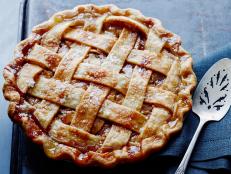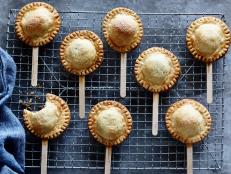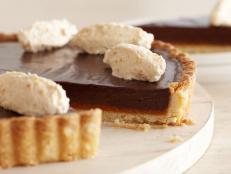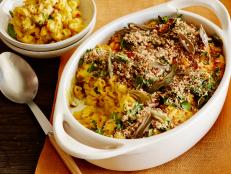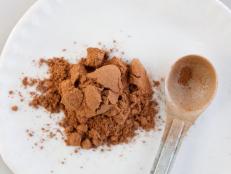The Best Pumpkin Pie: Squash Taste Test
On a quest to make the perfect Thanksgiving dessert, our brazen baking, taste-testing team analyzed pumpkin pies made from different squash varieties. Which squash reigned supreme? Click through for the colorful results.
Related To:
©2013
©2013
©2013
©2013
©2013
©2013
©2013
©2013
©2013
©2013
©2013
©2013
©2013
©2013
©2013
©2013
©2013
©2013
©2013
©2013
©2013
On a Quest for the Perfect Pumpkin Pie
Many consider pumpkin pie to be the most-important dish at the Thanksgiving dessert table (or perhaps more crucial to the feast than the turkey itself). But little attention is paid to the pumpkin –– or other kind of squash –– used in the making of the pie.
You can use canned pumpkin (which is often actually butternut squash) for a shortcut and guaranteed flavor, but when opting to start with a fresh squash, which one should you choose to roast and puree? Furthermore, how does the color and texture of the pie vary from squash to squash?
The Cooking Channel editorial and culinary teams decided to make delicious work of these questions by testing and photographing different squash varieties using the same pumpkin pie recipe. Flip through this gallery of squash and pie images for the beautiful, surprising pictures and tasting notes.
Get the Recipe: Pumpkin Pie
Roasts with the Most (Flavor)
Making pumpkin pie from fresh squash, rather than canned, requires a bit of work. Remove the seeds and fibrous strings from your squash of choice, then roast it at 400 degrees F for 30 to 45 minutes until a paring knife can easily be inserted and removed around the entire perimeter. Once the squash has cooled, remove the skin from the flesh and puree the flesh in a food processor until smooth (it should take three to four minutes).
Silky-Smooth Selection
Before baking each pumpkin pie, we compared and tasted the various pureed squash (and sweet potato –– more on that in a moment). We witnessed a surprising range in hue, texture and flavor. The red kuri and kabocha squash (part of the cucurbita maxima family) tasted quite creamy and possessed deep, vegetal flavor. The cheese pumpkin and canned pumpkin (butternut squash) of the cucurbita moschata family tasted bright and sweet, and were slightly less creamy than the maxima. And the acorn squash and sugar pumpkins (from the cucurbita pepo family) were thinner and tasted a bit bitter.
The Control
To establish a consistent flavor base, we included sweet potatoes in our test. Its expected color, consistency and flavor allowed us to judge the scale of pumpkin and squash results.
Pie from Up High
To compare the color of each pie, we photographed them from overhead. In keeping with the spirit of this taste test, which is about the taste of the pie's filling, we didn't worry about partially burned crusts or cracked pie tops. (But if you encounter similar issues, read here on how to fix those common baking disasters.)
By the Slice
We then peered into the profile of a single slice to get up close and personal with the pie's texture and color beneath the surface.
Canned Pumpkin
Canned pumpkin (which is usually pureed butternut squash) possesses a bright orange hue –– a sign of a pretty pie to come.
Canned Pumpkin
Indeed, the resulting pie is that perfect mix of orange and earthy brown tones.
Canned Pumpkin
The canned pumpkin was nicely creamy and possessed decent flavor, and though it was not the best textured or most aromatic of the bunch, it earns double points for the ease of preparation.
Cheese Pumpkin
This round taupe-colored squash is the sort of vegetable you'd expect to see on a decorative fall table.
Cheese Pumpkin
Slightly less orange than the canned variety, this pie appears more speckled as the various spices poke through the top of the crust.
Cheese Pumpkin
Like its cucurbita moschata sister, the canned butternut squash, the cheese pumpkin pie possesses a smooth texture and moderate depth of flavor.
Acorn Squash
This beautiful green squash possesses a rich flavor when roasted and pairs well with savory flavors. But how did it fare in the sweet pie preparation?
Acorn Squash
The brownest of the bunch, this pie possesses nary a trace of orange color, which is clearly the key to hiding those speckled spices. This pie is so polka-dotted, one might even find it off-putting.
Acorn Squash
While this pie was tasty, the bulk of flavor came from those visible spices, and less so from the squash itself. Our testers recommend concentrating the flavor of an acorn squash pie by straining the admittedly watery puree through a colander under a weight for at least a half-hour before making and baking the pie.
Sugar Pumpkin
These adorable orange globes are the sort of pumpkin most-often used when someone makes a pumpkin pie from scratch using a fresh squash. But does that make them the best?
Sugar Pumpkin
Despite the sugar pumpkin's vibrant skin, it settles to a sandy apricot once baked into a pie. Like the acorn squash, it reveals a fair amount of spices to the onlooker.
Sugar Pumpkin
This pie was perhaps the most surprising, seeing as how often sugar pumpkins are used in the preparation of pumpkin pie. The end result was weak, flavor-wise, and again the spices prominently stood out to testers. It was similarly watery, and testers suggest straining sugar pumpkin through a colander too.
Kabocha Squash
Rough around the edges, with an uneven, knobby texture and a mixture of green and orange skin, the kabocha squash was a question mark in the making of a successful pie.
Kabocha Squash
At first glance, the squash with the thickest texture (second only to the sweet potato) turned out a beautiful pie with a lovely burnt-orange hue.
Kabocha Squash
This second-place pie possesses a rich, creamy texture and deep pumpkin flavor that isn't overpowered by the favorite fall spices.
Red Kuri Squash
Like its name implies, this beautiful-to-behold squash is closer to a reddish vermilion color than any of its competition.
Red Kuri Squash
The red kuri puree was nearly electric in tone, resulting in a pie with a deeply colorful persimmon hue –– or quite close in color to a red curry dish.
The Winner: Red Kuri Squash
Edging out the kabocha squash by a hair, the red kuri squash was the unanimous winner of the taste test, for its thick, creamy consistency, lovely hue and uniquely sweet, rich flavor.
